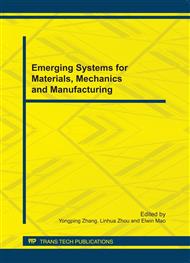p.3
p.7
p.12
p.17
p.23
p.28
p.32
p.37
Microstructure Modeling for Prediction of Thermal Conductivity of Plain Weave C/SiC Fibre Bundles Considering Manufacturing Flaws
Abstract:
The aim of this paper is to propose a microstructure modeling for prediction of thermal conductivity of plain weave C/SiC fibre bundles considering manufacturing flaws. Utilized photomicrographs taken by scanning electron microscope (SEM), an accurate representative volume element (RVE) model for carbon fiber bundles is established. Based on the steady-analysis method, the axial and transverse thermal conductivity of the carbon fibre bundles are calculated as 40.32Wm-1K-1 and 11.33 Wm-1K-1, respectively. The manufacturing flaws have different effects on thermal conductivity, the study shows that class A porosity has a significant effect on thermal conductivity, which leads to the thermal conductivity on the axial direction decrease by 13.31% and transverse direction decrease by 20.56% compared with no flaws RVE. While class B porosity has little influence on the k-value. The change law of axial and transverse thermal conductivity along with porosity volume is also observed: as porosity volume fraction is increasing, the thermal conductivity of fibre bundles shows significant linear decrease.
Info:
Periodical:
Pages:
17-22
Citation:
Online since:
October 2011
Authors:
Keywords:
Price:
Сopyright:
© 2012 Trans Tech Publications Ltd. All Rights Reserved
Share:
Citation:


